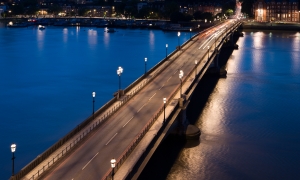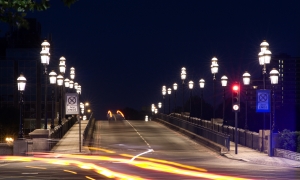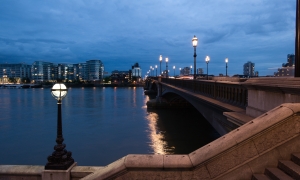In situ restoration of columns and replica exterior lanterns on Battersea Bridge
The challenge
Battersea Bridge, built in 1766, has been transformed over time from a narrow wooden bridge of 19 spans to the wrought-iron and steel construction with five spans of today and now takes both pedestrians and traffic across the Thames. Light spilt into the Thames, causing problems with the clarity of navigational lights and creating distractions for the captains of passing vessels. In addition, the uniformity of light on both the footpaths (one on each side of the carriageway) and the road was no longer effective.
DW Windsor was asked to restore lanterns and broken columns that had been damaged from years of use. The old lanterns used two light sources: 70W SON lamps for the main body and separate 11W PL compact fluorescent lamps for the top. The columns could not be removed from the site, so they would have to be restored on-site.
Clients and partners
-

Client
WSP
-
Client
TfL
The solution
DW Windsor was chosen for their extensive experience in the restoration of ornate lanterns. They recommended future-proofing their IP rating by creating replica lanterns in copper with polycarbonate glazing for longevity. These used their Diamond Optic®, which uses flexible patented technology to control light, distributing it uniformly and efficiently. The light distribution can therefore be independently adjusted for each lantern by adjusting the four multi-faceted internal reflectors (arranged in the shape of a diamond) to where it is required, eg projecting onto the carriageway and paths rather than the river.
White 45W CosmoPolis® lamps were chosen, for their inherent energy saving benefits, better colour rendering and brighter appearance. The replica lanterns were designed to allow a small amount of light to filter up into the top, keeping the character of the lantern but negating the need for a second lamp and minimising upward light.
Columns were shot-blasted, re-coated in a marine environment-resilient material and repaired, all in situ. Replica lamps were created and brought to the site.
The result is a vastly improved lighting effect with requisite light levels on the pavements and roads. The scheme won the Energy Management and Innovation Lighting (EMILAS) Award within the Road & Amenity category. Consumption is 50W per lantern as opposed to 94W of the earlier scheme – an energy saving of 45%.
Both carriageways of traffic and pedestrian access along one side of the bridge remained open at all times due to the diligent scheduling and discrete repair work carried out by the DW Windsor team.
" We were very impressed with the quality of lighting products and the obvious pride that DW Windsor’s people took in installing them on our recent Battersea Bridge Relighting project for TfL. We are confident that the excellent quality materials used and the exceptional workmanship involved in replicating the lanterns will ensure lasting enjoyment to the public for many years to come "
David O’Keefe, Senior Engineer at WSP


